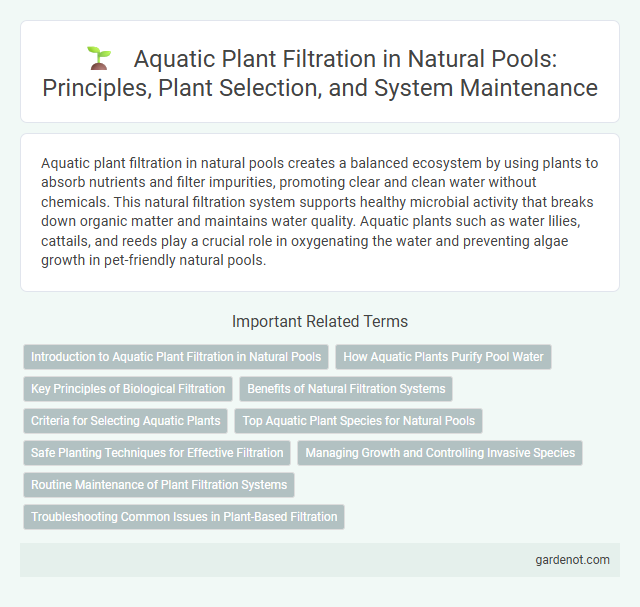Aquatic plant filtration in natural pools creates a balanced ecosystem by using plants to absorb nutrients and filter impurities, promoting clear and clean water without chemicals. This natural filtration system supports healthy microbial activity that breaks down organic matter and maintains water quality. Aquatic plants such as water lilies, cattails, and reeds play a crucial role in oxygenating the water and preventing algae growth in pet-friendly natural pools.
Introduction to Aquatic Plant Filtration in Natural Pools
Aquatic plant filtration in natural pools utilizes specific macrophytes to naturally purify water by absorbing nutrients and pollutants, thereby maintaining ecological balance. These plants enhance water clarity and support beneficial microbial communities that break down organic matter. Incorporating diverse aquatic plant species creates an effective biofiltration system essential for sustainable, chemical-free pool water management.
How Aquatic Plants Purify Pool Water
Aquatic plants purify pool water by naturally filtering out impurities through their root systems, which absorb nutrients and pollutants such as nitrates and phosphates. These plants promote beneficial microbial activity that breaks down organic matter, thereby enhancing water clarity and quality without the use of chemicals. Specific species like water lilies and cattails are highly effective in maintaining balanced ecosystems within natural pools, supporting sustainable filtration and oxygenation.
Key Principles of Biological Filtration
Aquatic plant filtration in natural pools relies on key principles of biological filtration, where submerged and marginal plants absorb nutrients and help break down organic matter, maintaining water clarity and balance. The root systems provide surface area for beneficial bacteria to colonize, which convert harmful ammonia and nitrites into less toxic nitrates through nitrification. This symbiotic relationship between plants and microorganisms stabilizes the ecosystem, reduces the need for chemical treatments, and ensures a sustainable, self-regulating aquatic environment.
Benefits of Natural Filtration Systems
Natural filtration systems in aquatic plant filtration enhance water quality by utilizing plants to absorb nutrients and pollutants, reducing the need for chemical treatments. These systems promote biodiversity by creating habitats for beneficial microorganisms that break down organic matter and contaminants. The result is a balanced ecosystem with clear, oxygen-rich water that supports aquatic life naturally and sustainably.
Criteria for Selecting Aquatic Plants
Selecting aquatic plants for natural pool filtration requires evaluating species based on their phytoremediation capacity, root structure, and oxygenation efficiency. Plants with extensive root systems such as water lilies (Nymphaea) and cattails (Typha) enhance nutrient uptake and provide habitat for beneficial microbes, improving water clarity and quality. Consideration of local climate tolerance and growth rate ensures sustainable filtration and ecosystem balance within the pool environment.
Top Aquatic Plant Species for Natural Pools
Top aquatic plant species for natural pool filtration include water lilies (Nymphaea) that provide shade and reduce algae growth, cattails (Typha) known for their efficient nutrient absorption, and hornwort (Ceratophyllum) which oxygenates water and inhibits harmful bacteria. These plants play a critical role in maintaining clear, balanced water by naturally filtering pollutants and supporting beneficial microorganisms. Selecting native aquatic species enhances biodiversity and ensures sustainable, low-maintenance pool ecosystems.
Safe Planting Techniques for Effective Filtration
Aquatic plant filtration relies on selecting native species with robust root systems to enhance nutrient uptake and minimize algae growth in natural pools. Safe planting techniques include avoiding overcrowding, maintaining proper spacing to ensure optimal water flow, and using biodegradable planting mediums to prevent chemical runoff. Regular monitoring of plant health and controlled pruning supports sustained filtration efficiency and ecosystem balance.
Managing Growth and Controlling Invasive Species
Aquatic plant filtration enhances natural pool water quality by promoting beneficial species that absorb nutrients and reduce algae growth. Managing growth involves regular trimming and selective harvesting to prevent dominance and maintain ecological balance. Controlling invasive species requires early identification and removal to protect native biodiversity and sustain effective natural filtration.
Routine Maintenance of Plant Filtration Systems
Routine maintenance of aquatic plant filtration systems involves regularly trimming plants to prevent overgrowth and ensure optimal water flow. Removing dead or decaying plant matter reduces nutrient buildup, minimizing algae growth and maintaining water clarity. Monitoring plant health and replacing ineffective species support the system's biological filtration efficiency in natural pools.
Troubleshooting Common Issues in Plant-Based Filtration
Aquatic plant filtration in natural pools can experience common issues such as algae overgrowth, plant die-off, or clogging of filter media, which reduce water clarity and ecosystem balance. Troubleshooting involves checking plant health, ensuring adequate sunlight and nutrient availability, and maintaining proper water circulation to prevent stagnant zones and excessive organic matter accumulation. Implementing regular pruning and introducing diverse plant species like reed beds and water lilies enhances filtration efficiency and supports a stable aquatic environment.
Aquatic plant filtration Infographic

 gardenot.com
gardenot.com